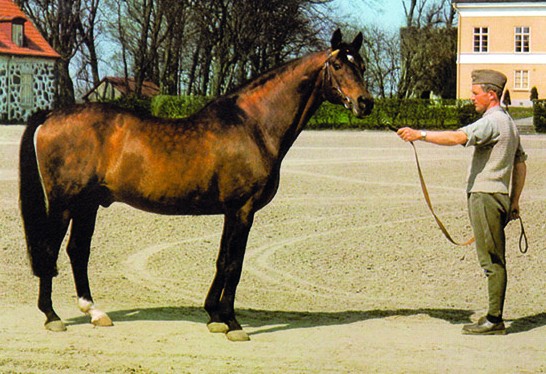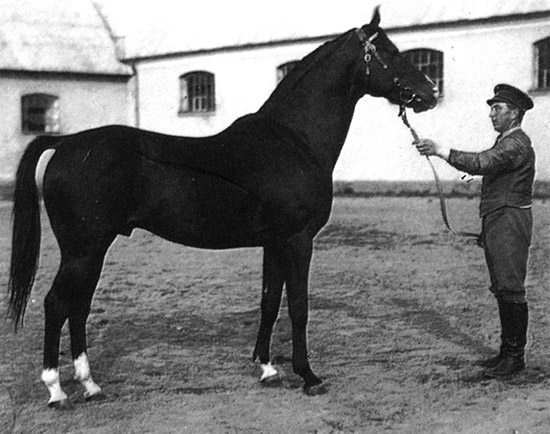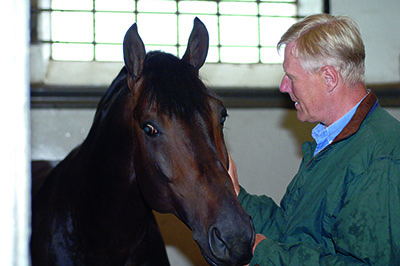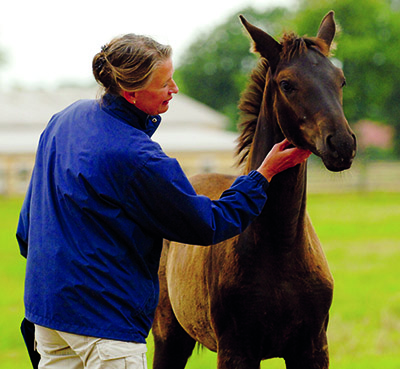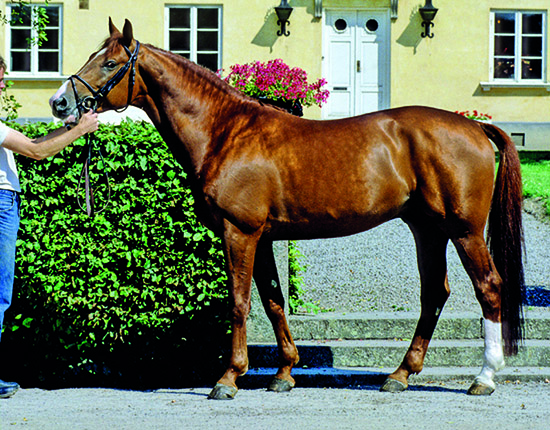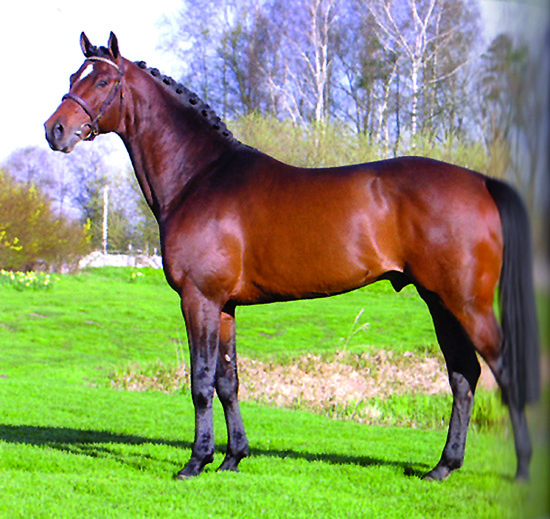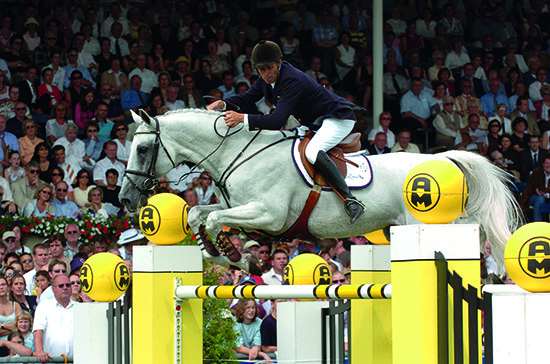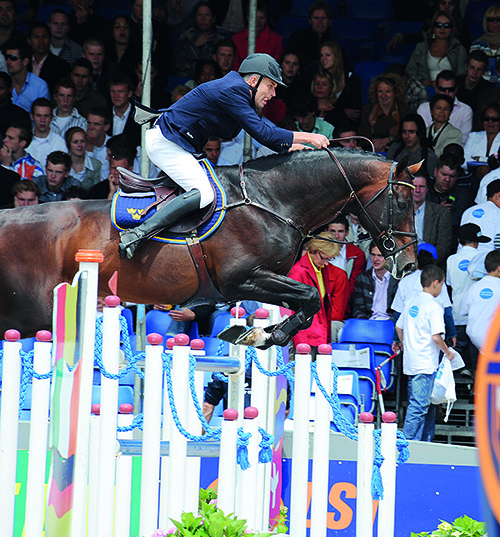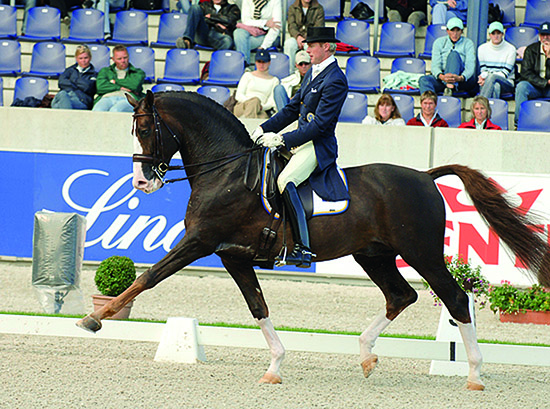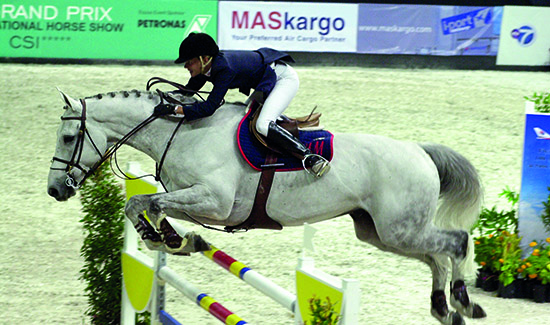Again in Swedish breeding history, we have that curious combination of church and cavalry that established so many of the early horse raising centres. It was in the 12th century that Bishop Absalon of Denmark established his cavalry horse breeding operation in what is now southern Sweden. When Charles X of Sweden acquired the district from the Danes in 1658, he established, three years later, the Royal Stud at Flyinge.
In 1747, Crown Prince Adolf Frederik was appointed the director at Flyinge, and he brought with him his own Holstein stallions. To this was added blood from the Hanoverian, East Prussian, Thoroughbred, Arab, Oldenburg and Frederiksborg horses, as the Swedish horse emerged over the next 150 years.
The stallion, Drabant, is a legacy of the Trakehners that came to Flyinge in the 1920s. Drabant descends from one of the most influential – Humanist. Drabant sired Wald who carried Gustav Fischer to a dressage silver medal at the 1960 Olympics.
By the 1920’s, the local Swedish mare owners had their choice of a number of high-class stallions standing at Flyinge. They included the Hanoverians, Schwabliso, Tribun and Hamlet, the East Prussians, Attino, Sonnesänger, Kyffhäuser and Humanist, and the Thoroughbred, Hampelmann xx. After the Second World War, an influential group of East Prussian (as distinct from Trakehner) stallions migrated to Sweden.
The Thoroughbred, Hampelmann, was influential in the 1920’s
Over the next twenty years, a number of these stallions – including Harung (Ilmengrunde/Altan), Heinfreid (Paradox xx/Camoens), Heristal (Hyperion/Haselhorst), Humboldt (Hutten/Paradox), Polarstern (Portwein/Alibaba) and Unikum (Traumgeist xx/Aquavit) along with the home-bred Drabant (Kokarde/Pergamon), Gaspari (Parad/Haffner), Jovial (Bohème xx/Trotz xx) and Lansiär (Niger/Florett) combined to produce a horse that grabbed the sales in the emerging dressage market – thanks in no small measure to the success of the competition stallion, Gaspari.
Certainly the Swedes had an advantage – when most of Europe was breeding heavy horses for agricultural work, Flyinge was always a source of riding horses. From 1100 to the 1940s, the breeding aim was horses for the cavalry, and the cavalry were still buying horses in the 1970s, but by then, the main breeding aim at Flyinge had switched to breeding sporthorses.
Since 1982, Flyinge was no longer government run; a private foundation was established with a charter to make it independent of government funding.. In 2005, the CEO was Bjorn Leander, who explained the set up to me:
“These days we have four core businesses: stud and sport, we have an education sector, we have a veterinary department, and finally, we have an events department. So we have four core businesses. We have about 60 employees, and the turnover is about 55 million Swedish krowns.”
And you breed mainly for the Swedish market, or for export?
“Mainly for the national market, but now we have the quality that we can export horses – and export semen as well.”
Birgitta Bentzer who is responsible for the breeding program, chimes in: “In this year’s breeding program we have twenty stallions that have covered about 1800 mares. We also send frozen semen all around the world – and we are sending fresh semen from Quite Easy to Italy this year. So roughly 2000 mares a year altogether. Mainly jumping stallions. We are improving the dressage breeding, but jumping breeding is much bigger. We also have some stallions that are very good for eventing.”
Your most successful jumping stallion has been Robin Z?
Birgitta: “Robin Z was born in 1983 and came here as a three year old. He was one of the first stallions to improve the jumping capacity of our horses. Before then was Irco Marco and before that Cortez. Amongst the younger ones is Cardento, who will have very great importance.”
Your success has been with the Holsteiner bred horses – now with Quite Easy you are bringing in the French blood of Quidam de Revel- is this a radical step?
“Normally we don’t use French horses that much, but Quidam de Revel was approved in Holstein, and it was from there that we got his blood, in combination with Landgraf. That seems to be a very good combination, Quidam de Revel has suited the horses in Holstein.”
“We have a good stallion son of Quite Easy, Qalle who is competing well at 1.50, 1.60…”
Amiral descends from old Swedish mare lines – he went Grand Prix with Kyra Kyrklund
That is important for you, that the stallions go out and compete?
Bjorn: “It is important that they compete not just for marketing purposes, but also to select the good stallions. To be a good breeding stallion they have to be a good sporthorse as well.”
At one stage Swedish dressage horses were very influential, but jumping breeding has taken over in your breeding area?
Birgitta: “There are many more riders in jumping than dressage so there is more interest in breeding jumping horses. We breed 70% jumping horses, 30% dressage horses.”
You are also breeding for eventing?
Bjorn: “Yes, but we think to have a really good eventer, it must be a very good jumper as well, much better jumpers than they used to be. Our Thoroughbred stallion, Eighty Eight Keys seems to breed very good eventers. We have another stallion, Qalle who we think will be a very good stallion for eventing, he jumps well and he is very good in dressage and he is a brave and very sound horse.”
With all these imported bloodlines, is it difficult to keep the traditional Swedish lines alive?
Bjorn: “We see ourselves as breeding a European Warmblood – the difference, for example, between Holstein and Hanover is not as big as it used to be. We want to breed an international horse. Of course we have some good old Swedish mare lines – for example, Qalle is from the same mare line as Amiral. But at the very beginning all of these lines come from the Hanoverian and the Trakehner, horses that were imported in the 1920’s. We have always imported horses – Thoroughbreds, Russian horses and German horses as well.”
What bloodlines are you looking for in your dressage-breeding program?
Birgitta: “We have Donnerhall, and Sandro Hit, a great grandson of Florestan, a grandson of Rubinstein. We have a Holsteiner, L’Acteur, by Lorentin, who went Grand Prix dressage – he’s a good jumper but we breed him mainly for dressage.”
Quite Easy – 300 mares…
Are there many private stallions in Sweden?
Bjorn: “Most of the breeding is done by private stallions – altogether there are about 180 private stallions and we have 20. Our market share is 37%, which means that our stallions serve many more mares per stallion than the private stallions. For the past couple of seasons, Quite Easy, for instance, bred about 300 mares a season and that is a lot.”
Are you moving in the direction of specialised lines of jumping and dressage stallions?
Birgitta: “Yes. It is much easier to make a jumping horse into a dressage horse than the other way around – you can never do that. But a horse like Qalle, he could do both.”
Do you have a 70 day or a 30 day performance test?
Brigitta: “Neither. We have a Stallion Test in February. The youngest the stallions can come to that test is as three year olds, but very very few stallions are approved at three. At this test they are shown in hand, and under saddle as well, and there is also a veterinary inspection, a conformation inspection, a free jumping test. They have to be really really good to get through – 40 points for conformation out of 50. Sandakan was one of the few that passed as a three year old, and he received 42 points for conformation. They have to have an average 8.5 for the gaits. At three years old they are only licensed for one year, they have to do a new test at four years old. They are then approved until they are six years old, and then there is another evaluation. If at that stage the progeny is not good enough, they are out!”
How strict are you in the veterinary examination – what about OCD?
“We have no OCD, not for the last ten years. The stallions that go into breeding are not allowed to have any OCD, they have to be absolutely clear. Of course some of the mares can carry OCD, but the stallions are all clear.”
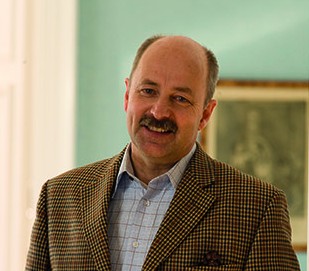 Karl-Henrik Heimdahl, was appointed breeding director at Flyinge in October 2009, but he has long been involved with horses. Karl-Henrik commenced practice as an equine vet in 1997, and before becoming breeding director at Flyinge was a conformation judge and President of the Swedish Warmblood Stallion Commission. He feels that he has taken up the reins when the breed is at the crossroads as he explained in an interview in 2010:
Karl-Henrik Heimdahl, was appointed breeding director at Flyinge in October 2009, but he has long been involved with horses. Karl-Henrik commenced practice as an equine vet in 1997, and before becoming breeding director at Flyinge was a conformation judge and President of the Swedish Warmblood Stallion Commission. He feels that he has taken up the reins when the breed is at the crossroads as he explained in an interview in 2010:
“I think we are in a phase where we need to step back a little bit and see where the future is going to do for us. We’ve had a period now since the middle of the 80’s with a very quick development of our horses, especially on the jumping side. We came from quite a low position to being amongst the world’s top nations. A lot of it was our own breeding, but mainly through the import of a lot of Holsteiner blood, and also a lot of Dutch blood to improve the jumping of the mare lines we had. It’s been very successful.”
“We’ve always had very good dressage horses in Sweden. In the 40s and 50s, our horses dominated, and while those horses have developed, I don’t think it has been quite as quick as what we did with the jumping horses.”
“The development of the modern horse is going quickly all over the world, and we have to take the next step forward. We are looking for new bloodlines for the dressage, and bloodlines for jumping that would consolidate the jumping horses we have now, and complement them.”
What are the important jumping stallions that you are using in Sweden at the moment?
“The most dominating stallion in the past ten years has been Cardento who came from Holland. He has really dominated the production of jumping horses in Sweden, his offspring are just over-whelming in young horse competitions. They all jump fantastically and they are now in the age where they start having international success. What I need to be looking for is to find bloodlines that would go very well with the Cardento mares because they are the gene pool that will take us to the next level.”
Cardento in action with Peter Erikson – the stallion is now back in Holland at VDL
“For those mares I am not looking for specific bloodlines but what we need is a bloodline that would produce a little bit more suppleness in the top line, improve the canter and consolidate the type. Sometimes they are a little stiff but they have all the scope in the world and they have the right mind, so many good things – if we can improve on those traits we can make a big step forward.”
Robin Z was a good sire of performers but he doesn’t seem to have left a stallion son?
“No he hasn’t. We tried a few stallions from him, many went to the selections but they tend to become too heavy, and not very modern in type. The ones that have been approved have not been that successful with the breeders, so it doesn’t seem we are going to be able to continue that line. The only one approved in Sweden now was out of a very good Carthago mother line, a super jumper when it came to scope, but type-wise not very much favoured by the breeders, so he is not used very much. We are still looking but Robin has done very well when you look at the competition horses, with mares – they are lighter in type and they are more sporty in the conformation.”
Jaguar Mail – now in England and siring eventers
Jaguar Mail, the French stallion that came to Sweden, has he worked?
“They are too young so far to tell. I have myself one of the oldest in Sweden, made before he came to Sweden, and she is going to be the first of his in the three year old test. His first crop was quite large and they are two year olds now, so it is going to be very interesting to see. He is a big horse with a lot of Thoroughbred in him, theoretically he should be a good combination with our mares but we have not been able to evaluate the offspring as yet. They look good, they have a super mind, temperament wise they are superb, but we’d like to see what happens when we start jumping them. We have started free jumping them and next spring we will have enough horses by him through the evaluations to have a good idea of how he works with Swedish mares. I am hopeful, he is a beautiful horse, but he is dividing the breeders in two categories, the ones that hate him and the ones that love him. That has to do with his rather odd technique over a fence, he has all the scope in the world, he has a great rideability, he has a front limb technique that is not optimal, which makes some breeders very negative to him, others say with a good mare that is nice in front with good reflexes, it doesn’t matter because he gives so many other good qualities, it’s interesting.”
In dressage, which are the more important stallions at the moment?
“Right now we don’t have a stallion that is dominating the market. We have a lot of stallions that are used, a lot of young stallions. We are trying to find the next step. I think here we are looking for younger stallions to improve the type of our dressage mares which is a little behind the rest of Europe, I think. We are looking for stallions that give more of an uphill conformation. For a long time in Sweden we have been focussed on improving the neck set, to improve the hind limb activity and we have been successful in doing that, but along the way we lost a little bit of the freedom of the shoulder and we still haven’t got the natural uphill tendency that we would like to see. So we need to improve that and we are looking for the stallions that can do that. Some of that I think we can find in the Dutch bloodlines.”
Have you used Dutch blood so far?
“A little bit, we have been using a lot of German bloodlines. We have a lot of Donnerhall blood lately, Donnerhall and Donnerhall sons have produced really well with Swedish mares, rideable, nice horses but not really the refinement and electricity you would like to see in a modern dressage horse. So we need to get that somewhere else, and I think some of the Dutch stallions would fit very well with the Donnerhall / Swedish combination that we have.”
Briar – not popular in Sweden…
I was surprised looking at the number of mares being covered that Briar doesn’t seem to get mares in Sweden…
“Not very many, he has been covering 30/35 mares a year for a long time and it doesn’t seem to get less or more. It is strange from the point of view that he is a fantastic international horse. I think we are in a process where the people who breed in Sweden are different, there are a lot of people who are very influenced by what is modern, what everyone is talking about right now – and not so influenced by long term breeding strategies, they want what is flashy and modern. Now I am being critical of these breeders, but they would rather seek something that is fancy from abroad than look at what we have in the country that has proven itself. I find that problem with some other proven stallions as well. There is more demand for flashy, young unproven stallions than the ones that have really proven themselves in the sport. Then when we talk strategies with our breeders, everyone says, I want to use a stallion that has gone all the way. So we present them with stallions that have gone all the way, and they don’t use them. Briar is one, Lingh is another fantastic sport horse of a lighter model than Briar, which would suit a lot of our mares, but again they go for the younger, flashier horses, there is not a lot of sense involved…”
Do you feel that you have to make a choice – breed for the elite sport horse or for the amateur rider market?
“We are trying to breed for both markets with the same strategy. I think for the private riders that works. We have a little bit of a problem with the riding schools, which is a very big base of the equine industry in Sweden. Most kids start in Riding Schools, and we’ve had established schools for many many years. That’s a little different from other European countries – and they are looking for calmer horses, not so sensitive horses that can tolerate a rider that is learning. With some of the modern lines, that sort of horse is difficult to find. I know that some of our riding schools are trying to find other horses, not the ones we breed for the sport market.”
“Some lines certainly have a temperament that is perfect even for the riding schools and also for sport horses, but it is not always that way.”
Irco Sun and Malin Baryard – by Irco Mena by Irco Marco…
“For instance in Sweden we have the Irco Marco line for jumping, they are very rideable horses, very sensible horses, a little bit late developers but you can use them for anything. The can go well in Riding Schools, but they can also be top jumping horses internationally. Irco Marco is one who has produced a good sire line in Sweden, with several approved sons who are doing well in the sport and in the breeding as well, unlike Robin Z.”
You are optimistic for the future of the Swedish horse?
“Yes I am, but I think we are more and more going into developing the European Sport Horse. From a different mare base, but it gets hard to define what the Swedish horses are now because with all the import of semen from nice international stallions into the breeding, it gets less obvious what is actually Swedish compared to German and Dutch. If you look 15, 20 years from now, we’d be more like the European Sport Horse, the characteristics of the different breeds will be less obvious.”
Karl-Henrik feels that one of the strengths of horse breeding in Sweden has been a rather different stallion test:
“Our test is quite different in length from the others. When we started testing in the mid-80s, we had a long argument with our breeders about what to do. We needed a better test of the stallions, but we were not wedded to just copying what the Germans did. At the time everyone was copying Germany. We made a very thorough research into the strengths and weaknesses of the 70 and 100 days tests, and we decided we wanted to do it differently. We have an eight to nine day test that is divided into two phases. Everyone can enter in the first phase, and they are checked on veterinary soundness, checked for conformation, gaits under the rider – with their own rider – then jumping free or with their rider, depending on the age of the horse.”
“After those evaluations, the committee will recommend a number of these stallions to go to phase two. We say to the owners of the rest of the stallions, thank you very much but this horse is not good enough, it is not going to be approved. There is always a group where the horses have shown something but not enough to be convincing, and usually we would discuss with the owners of those horses, the strengths and weaknesses, and from that information they can decide to go on to the second phase or not. They know their own horses and whether they presented themselves in the best way or not. If they go into the second phase, then the dressage horses do another gait test under their rider, and then they are ridden by test riders. The same goes for the jumping horses, once more on a little bit tougher course with their own riders, then the test riders. On the basis of the total information that the committee gets from these evaluations, the stallion is given an approval for six years or not. Three years olds, are approved for one year, and then have to do the test again as a four year old.”
“It is interesting that our test is much shorter. You don’t have to leave your stallion somewhere for a long time where you have no control of who rides it. You do the training period at home with your own rider. We have been doing that since the mid-80s and we can see it from the genetic evaluations, that we are really selecting just as well as they are doing with 100, 70 or 30 day tests. The genetic correlation between the performance test and the results in the sport and in breeding for these horses is very high. So for us, we think it is a very good system.”
Footnote: Sadly the strategy did not work, and today, Flyinge is no longer a breeding centre and the future for the Swedish horse is clouded.



